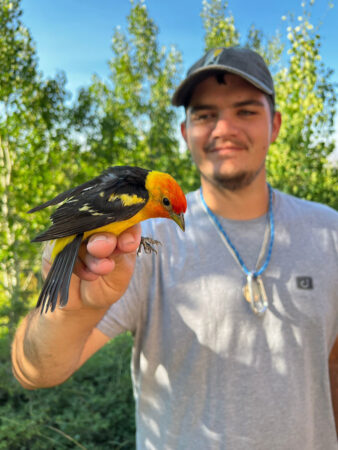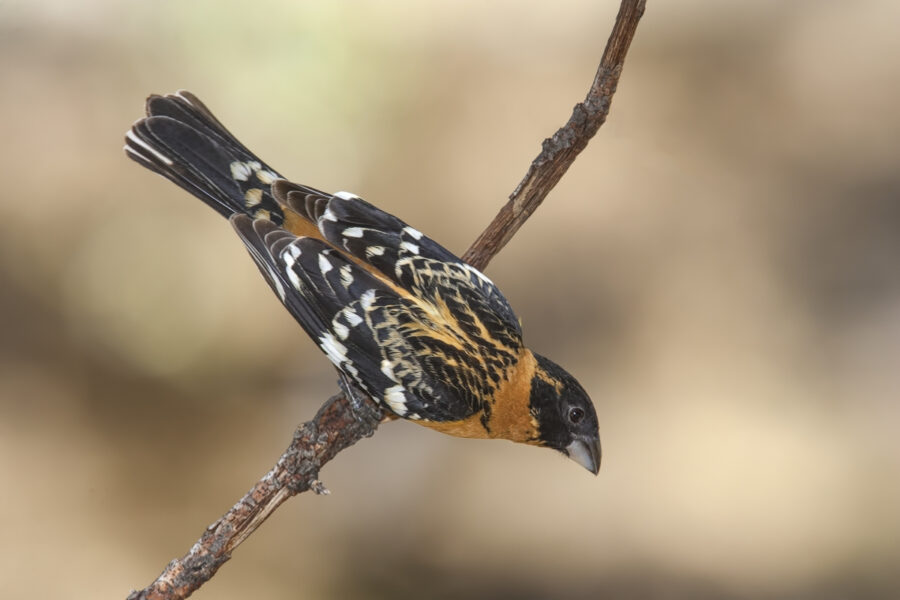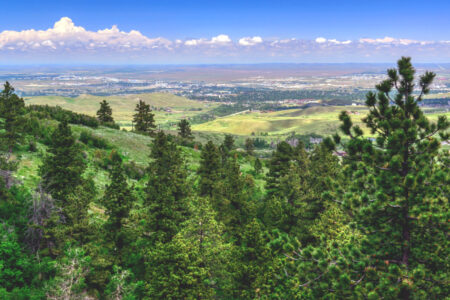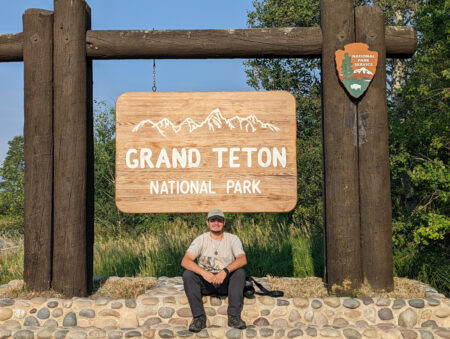
Chris Johnson is a 21-year-old birder, photographer, and conservationist from The Bahamas, and a student at Holland College in Prince Edward Island, Canada. In March 2022, he attended BirdsCaribbean’s first Caribbean Bird Banding Training Workshop in Nassau, The Bahamas, where he had his first experiences learning about bird banding as a tool for research and monitoring. After the workshop BirdsCaribbean selected Chris for a Bird Banding Internship, so that he could continue to train and hone his banding skills. Here, Chris shares his experiences banding birds this summer with Audubon Rockies in Casper, Wyoming.
The well-known phrase “A bird in the hand is worth two in the bush” is true even in the literal sense. The movements of birds during migration, their age, body condition, reproductive status, population trends, and more can all be discovered with birds in the hand. Banding is an important tool for understanding how wild bird populations are faring. I was thrilled at the opportunity to further my knowledge of bird banding in Casper, Wyoming, and especially excited to travel to one of my bucket list locations, the magnificent Rocky Mountains!
My first impression: My mind was blown!
Upon arriving in Casper, I was blown away by the incredible landscapes that I’d never seen before. The sweeping grasslands with picturesque hills and mountains were something I had always dreamt of seeing. I experienced new habitats such as riparian wetlands, grasslands, and subalpine forests, along with the birds that inhabit them, such as Black-billed Magpies, Western Tanagers, and Black-Headed Grosbeaks. This was just the start of an unforgettable experience to come.


A busy banding day
As I woke up on the first day of bird banding, I was excited to begin banding and handling some amazing new birds in a new location. Upon arrival at Edness K. Wilkins State Park, the temperature was 36 degrees Fahrenheit (2.2 degrees Celsius); a wee bit chilly for this Bahamian. While we ended up having to wait an hour or two for the temperature to warm up a bit, our total number of extracted and processed birds at the end of the day was close to 60 individuals! In previous banding experiences back at home, more than 20 birds made for an extraordinary day. While it was the busiest banding day I’ve ever had, it was a great way to kick off the start of the banding season in Casper and set the tone for what was shaping up to be a great summer.

As I had very little experience in extracting, processing, and banding birds, the first few banding sessions helped to refresh my memory on handling birds safely and bird banding ethics. I had the pleasure, during my internship, of working closely with Zach Hutchinson (Community Science Coordinator of Audubon Rockies). I learned how to run an effective banding station and the “ins and outs” of processing the data collected from migratory and resident songbirds.
More local banders needed in the Bahamas
I am currently studying wildlife conservation at Holland College in Prince Edward Island, Canada. I hope to return home to The Bahamas to start a banding station and begin collecting data on our resident and migratory bird species. The Bahamas does not currently have any active bird banding stations run by a local person. . While some birds have been studied in The Bahamas by US and Canadian scientists, it is crucial to have more Bahamians with intimate knowledge of the local birds and their behavior to lead this research and advance Bahamian bird conservation.
Zach has had many years of experience operating the bird banding stations in Casper. He has a thorough, comprehensive knowledge of how to run an effective bird banding station, extract and process various bird species, and train volunteers.. As the Casper stations are quite small, it was easy for Zach to share his knowledge with me. I learned more about bird banding in the past three months from Zach and the folks at Audubon Rockies than I would have learned in a year back at home!
A giant leap in banding experience
I had the opportunity to band at Keyhole State Park and at a site on Casper Mountain, besides Edness K. Wilkins State Park. The primary training I received was in banding songbirds but I also got great practice with hummingbirds and Mourning Doves. Before this internship, I had only extracted a total of two birds from mist nets and banded one. After this internship, I can say that I have extracted approximately 105 birds and banded approximately 99! While I’m just starting my bird banding training journey, this internship has given me knowledge in extracting birds from mist nets, identifying molt stages of different birds, sexing and understanding the health of birds in hand, and using the new Wolfe, Ryder, Pyle (WRP) codes to accurately determine the age of a bird.
While we extracted and banded many common Wyoming birds like Yellow Warblers, Common Grackles, and American Robins, some of my favorites for practicing extractions and processing were House Wrens, Black-capped and Mountain Chickadees, Bullock’s Orioles, and Black-headed Grosbeaks.
Not all banding stations are the same
While the BirdsCaribbean Banding Workshop back home served as an incredible introduction to the world of bird banding, every station operates a bit differently. Each will use slightly differing methods for station setup, net setup and extraction, and for processing birds, to operate at the highest efficiency. Banding equipment in The Bahamas differs quite a lot from the banding equipment that we used in Casper. The methodology for setting up an effective bird banding station was also quite different. Nevertheless,I cannot wait to utilize some of these new methods and tricks to enhance bird banding when I return to The Bahamas.
Although the training was the main purpose of my internship, I also grabbed the opportunity to see much of Wyoming on days off! A personal favorite would have to be the jaw-dropping Yellowstone and Grand Teton National Parks. I also truly enjoyed attending my first ever BioBlitz in Guernsey State Park, documenting the incredible fauna that Wyoming has to offer. A BioBlitz is a fun but intense event where students, teachers, volunteers, and scientists collaborate to survey as many species of flora and fauna in a particular area over the span of 24 hours.

After attending this internship, my appreciation of bird banding has grown exponentially. I hope to continue practicing my bird banding skills before returning home to The Bahamas. My goal is to eventually start my own MoSI (Monitoreo de Sobrevivencia Invernal/Monitoring Neotropical Migrants on their Wintering Grounds) stations, while studying migratory, endemic, and range-restricted Bahamian bird species.
I know I still have a lot to learn when it comes to bird banding. But now I am inspired, and eager to see what the future holds for bird research in The Bahamas. I want to contribute to it back home, in some way.
I’d like to thank Zach Hutchinson and all the folks at Audubon Rockies for all of their support and training over the summer, and Nate and Jenny Edwards for their incredible hospitality and welcoming me into their home for 3 months. I’d also like to thank Ellis Hein and Stacey Scott for their efforts during the banding season and showing me around Casper, and getting some new lifers along the way. Lastly, I’d like to thank Holly Garrod, Maya Wilson, and everyone at BirdsCaribbean for making this summer possible. Without their support I wouldn’t have had this incredible opportunity and experience to band birds in this remarkable location.
BirdsCaribbean would also like to thank Zack Hutchinson and others with Audubon Rockies for supporting this training. Chris’ internship was funded in part by the US Fish and Wildlife Service, Neotropical Migratory Bird Conservation Act (NMBCA) Fund.


